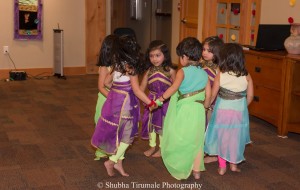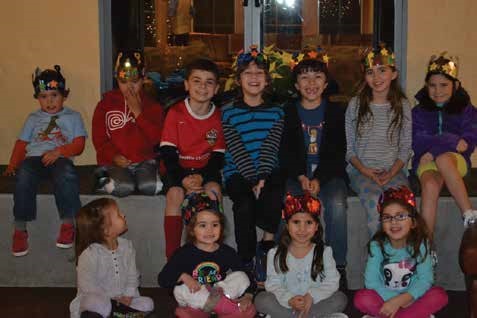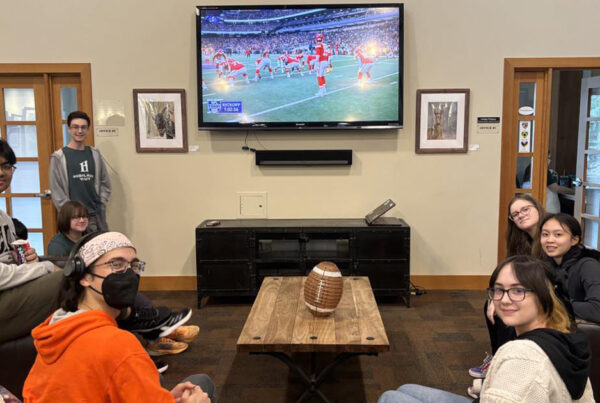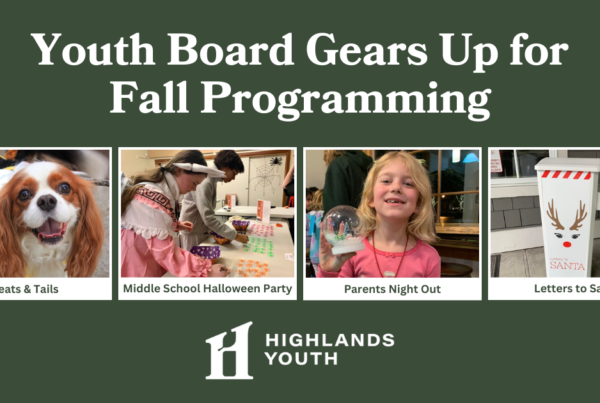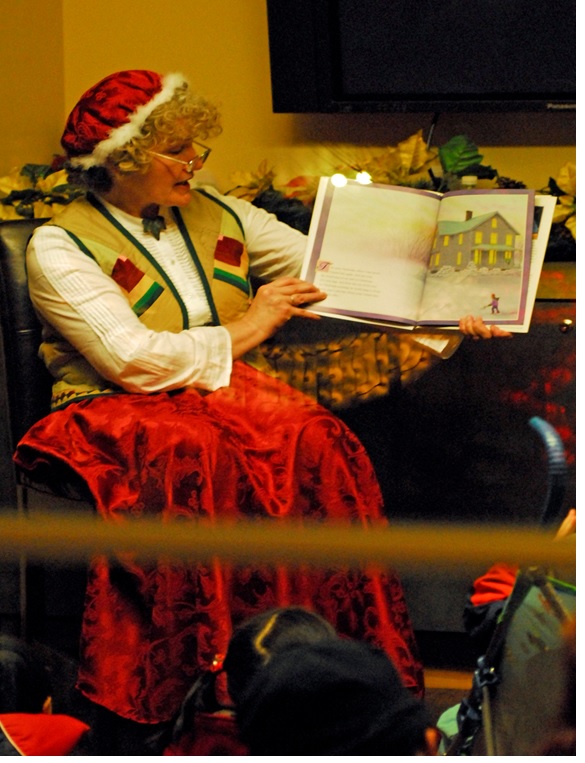
‘Diwali’-A Galore of Happiness
By Anita Ayela, The Cottages
‘Diwali’ is the short form of the word ‘Deepavali’ which means an Array of lights. Though there are different stories pertaining to the celebration of this festival in India, everything points in the same direction, the direction of prosperity and happiness. In India, though it is a Hindu festival, Diwali is celebrated by all religions as the festivity of lights and fireworks.
In the southern part of India, Deepavali starts with girls wearing new clothes and making Rangoli in front of their houses. They pray to the Goddess of Wealth, Lakshmi, and offer sweets to her. A day prior to Diwali is celebrated as ‘Naraka Chaturdashi’, the day Lord Krishna’s wife Satyabhama, killed the demon ‘Narakasura’.
In the east, in the states of Bengal, Orissa and Assam, Goddess Kali, another form of Lakshmi, is worshipped on the Diwali day. An idol of Kali is installed and in the night, fireworks are initiated at the Kali pandal (pedestal) first, and then in individual houses.
In North India, Diwali is celebrated for another God, Lord Rama. The belief is that Rama returned home on Diwali day after 14 years of exile, and hence all lights are to welcome him. Fireworks sparkled when he was crowned the King. An edifice of Ravana, the demon King, is lit up on every Diwali, signifying the end of evil.
In the western part of India, in Maharashtra, Gujarat and Rajasthan, people worship for five days, inviting the Goddess of wealth, Lakshmi, to their houses. According to the Gujrathi calendar, Diwali is the start of a new year, and so it calls for double celebrations.
Diwali celebrations always start about a month before the actual date. New clothes, sweets and fireworks are bought. In my house on the Diwali day, my mom made a lot of sweets and I continue the tradition here in the Highlands. As kids, it was fun to light the ‘Diyas’ or the small decorated clay pots and arrange them outside the house at every door and window. Here, I buy the diyas from one of the Indian stores in Bellevue and my kids decorate the house. They wear ethnic clothes bought from the Indian shops in Renton or Redmond.
In 2003, when the White House officially recognized Diwali, Indians in America were overjoyed beyond compare. Now in America, Americans are eager to join the Diwali cultural events to get a feel of India’s culture.
In November, Issaquah Highlands witnessed a grand celebration of Diwali organized by the India Cultural Club for the highlanders. The Rangoli, the Henna, the dances, the songs, and the food from Indian cuisine, gleamed of the Indian culture, entertaining and enticing everyone. In India, all Diwali celebrations would end with the sounds of fireworks, which every person would light and enjoy. Here too, every year we go to the Hindu temple in Bothell to watch the fireworks show and light the sparklers that they provide! Any celebration with friends and family always invokes happiness!!!
Gulab Jamun
This Diwali sweet is a melt-in-the-mouth sweet that is so typical Indian that it is available in almost all Indian restaurants. This is an easy to make version of the otherwise elaborate process of making it.
Ingredients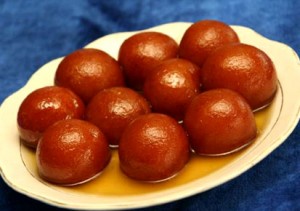
1 cup Milk Powder
1/2 cup Whole milk
1/4 cup unsalted butter
4 tsp All Purpose Flour
Oil for frying gulab jamun
For Sugar Syrup
2 cups Sugar (400 grams)
1 cup water
Method:
Take butter in pan and melt it; add milk and mix well. Cook it on low flame. Now add milk powder and stir constantly till the mixture is smooth and doesn’t have any lumps. Once, it is ready, turn off the flame and take it out in a bowl. Add the all-purpose flour and knead until it gets smooth in texture. If the mixture appears to be dry, add a little milk into it and knead.
Put sugar and 1 cup water in a pan and cook until the sugar dissolves completely. Now check the sugar syrup by dropping 1-2 drops on a plate. With help of your thumb and finger check the syrup. It should be gooey in texture. Sugar syrup is now ready, turn off the flame. Add cardamom powder in the syrup and mix well.
Preheat oil in a pan. Take small amount of the prepared dough and make a ball and drop it into the oil for frying. Fry until it gets golden brown in color. Take out the fried gulab jamun and place it on a paper napkin to soak the excess oil. After 1 or 2 minutes, transfer it into the sugar syrup. Prepare all the gulab jamun. Let the gulab jamuns soak in the sugar syrup for at least one hour so that they are sweet enough.
No Matter How We Spell It, Hanukkah Lights Up Our Lives
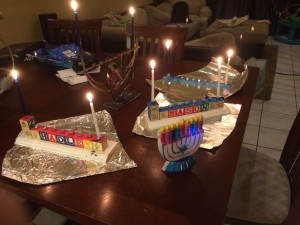 By Molly and Marty Fisher, Ashland Park
By Molly and Marty Fisher, Ashland Park
Although we’re never really sure which way to spell it, we always look forward to celebrating Hanukkah. For us, it’s eight wonderful nights of celebrating miracles, lighting candles, laughing, singing, exchanging gifts, and eating delicious fried treats with family and friends.
What’s not to love?
Chanukkah, the Festival of Lights, commemorates the unlikely victory of the ancient Israelites over the Syrian Greek army and the miracle that followed when a single day’s vial of oil lasted for eight days in the Holy Temple in Jerusalem. The word Hanukkah means dedication in Hebrew, which is what it takes to launch a war against a superpower and light a single flask of oil that can’t possibly last long enough. The moral of the story is simple – with enough dedication and commitment, miracles really can happen.
Let’s clear up a major misunderstanding right away – Chanukah is not the Jewish Christmas. Although we love giving and getting presents, there is no historical significance to giving gifts on each night of the holiday. There is, however, a tradition of giving kids “gelt” (money) as an incentive to learn Torah (the law of God as revealed to Moses and recorded in the first five books of the Hebrew scriptures). In our house, we exchange gifts with a different theme each night. There are the practical gift nights – like socks and underwear – but there also are mystery nights with fun gifts that make us all feel like little kids.
We celebrate each of the eight nights by lighting the menorah, one of the oldest symbols of the Jewish faith. During Hanukah, the nine-branched menorah, or hanukiah, is used for eight nights, with a new candle lit each evening at nightfall from left to right using the “shamash” – the raised, middle helper candle. By the end of the eighth day of Chanukah, each menorah burns through a total of 44 candles, hence the Festival of Light.
With the exception of a few wildcards, there are 16 different spellings for Hanukah based on four phonetic variations: the word starts with “H” or “Ch”, the second consonant is either “nn” or “n”, the third consonant is either “kk” or “k” and the word ends with either “ah” or “a”. Although the most common spellings are Hanukkah and Chanukah, you get to choose. The reason for the differences is transliteration, changing letters or words into characters of another alphabet or language. In Hebrew, the word for Hanukkah is not easily transliterated into English.
In our house, we love to play dreidel (a 4-sided spinning top), and eat latkes (fried potato pancakes – yummy!) topped with applesauce. Jelly doughnuts also are popular because many Hanukkah foods are deep-fried in oil, symbolizing the oil from the menorah used in the Temple – not a good time to start a diet!
Our favorite Chanukkah memory is laying the gifts on the floor of the living room of my parents’ home with a pile for each person in the family. With the fabulous aroma of latkes wafting through the air and our stomachs full of these fantastic fried delights, the kids tore open their gifts with joyful abandon, laughing, screaming, and jumping up and down! It’s one of those rare moments in life when everything comes together in a perfect package – religion, tradition, culture, family, friends, and, of course, food!
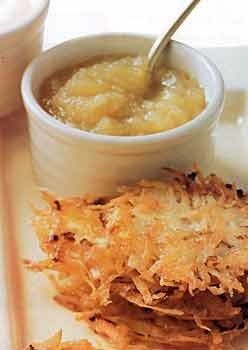 From our family to yours, here’s to a miraculous holiday filled with light and love!
From our family to yours, here’s to a miraculous holiday filled with light and love!
Latkes
Makes 12 to 16 latkes
Ingredients:
1 pound potatoes
1/2 cup finely chopped onion
1 large egg, lightly beaten
1/2 teaspoon salt
1/2 to 3/4 cup olive oil
Accompaniments: sour cream and applesauce
Directions:
Preheat oven to 250°F. Peel potatoes and coarsely grate by hand, transferring to a large bowl of cold water as grated. Soak potatoes 1 to 2 minutes after last batch is added to water, then drain well in a colander.
Spread grated potatoes and onion on a kitchen towel and roll up jelly-roll style. Twist towel tightly to wring out as much liquid as possible. Transfer potato mixture to a bowl and stir in egg and salt.
Heat 1/4 cup oil in a 12-inch nonstick skillet over moderately high heat until hot but not smoking. Working in batches of 4 latkes, spoon 2 tablespoons potato mixture per latke into skillet, spreading into 3-inch rounds with a fork. Reduce heat to moderate and cook until undersides are browned, about 5 minutes. Turn latkes over and cook until undersides are browned, about 5 minutes more. Transfer to paper towels to drain and season with salt. Add more oil to skillet as needed. Keep latkes warm on a wire rack set in a shallow baking pan in oven.
Cooking notes:
Latkes may be made up to 8 hours ahead. Reheat on a rack set over a baking sheet in a 350°F oven, about 5 minutes.
Grating the potatoes, soaking them briefly in water, and then squeezing out the liquid keeps the batter from turning brown too quickly.
By Alicia Spinner
Every year on January 6th our family celebrates Kings’ day. According to the Christian story this was the day in which the Three Kings -Melchior, Caspar and Balthazar- arrived bearing gifts for baby Jesus.
This tradition at our house marks the end of the holiday season and we gather together with family and friends to celebrate how fortunate we are. We always have a very special sweet bread, the Rosca de Reyes (or King’s Bread) that is a staple of this holiday in many countries of Latin America and Spain. It has a round shape as an allusion to a King’s crown, and it is decorated with candied fruits that represent jewels.
All kids and adults love this pastry, and we enjoy eating it with a delicious Mexican Hot Chocolate. But the part that kids enjoy the most is that this bread has hidden inside baby Jesus figures, around three or four, depending on the size of the bread.
The tradition says that whoever finds a figurine in their slice is blessed, and in Mexico the person who finds it has the responsibility of hosting a dinner with tamales and atole on February 2nd, the day of the Candlemas.
I like to believe that this is a way to extend the holiday’s season, and to have more excuses to get together and to enjoy each other company. However, my kids and their friends are just happy to get one of the figures and be the ones that will keep such a special treasure.
I get our King’s Bread every year online (www.mexgrocer.com), it comes directly from El Molino bakery of Mexico City. But there are some local stores that sell them, as La Venadita Store in Gilman Blvd. They put them on the shelves the day before this holiday, and they are normally sold out by noon on King’s Day.
We also celebrate this holiday as a community; the IH Latino Group has been getting together every year to share a King’s Bread. If you would like to try it, please stop by. We would love to give you a slice. Who knows, maybe you will be one of the blessed ones this year!
King Cake
Ingredients
1/2 cup warm water (105 to 115 degrees)
2 packages dry yeast
2 teaspoons sugar
4 to 5 cups flour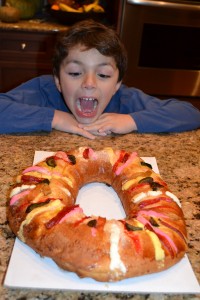
1/2 cup sugar
2 teaspoons salt
1 teaspoon ground nutmeg
1 teaspoon grated lemon rind
1/2 cup warm milk (105 to 115 degrees)
1/2 cup melted unsalted butter, cooled
5 egg yolks
1/2 cup finely chopped candied citron
1 pecan half, uncooked dried bean or King Cake Baby
Glaze:
2 cups sifted powdered sugar
2 tablespoons lemon juice
2 tablespoons water
Purple, green and gold sugar crystals
Directions
Preheat the oven 350 degrees. Combine the warm water, yeast and 2 teaspoons sugar in a small bowl. Mix well and set aside to a warm place for about 10 minutes. Combine the 4 cups of flour, 1/2 cup sugar, salt, nutmeg, lemon rind and add warm milk, melted butter, egg yolks and yeast mixture. Beat until smooth. Turn dough out on a lightly floured surface. Knead in enough remaining flour until the dough is no longer sticky. Continue kneading until the dough is smooth and elastic (about 10 minutes). Place the dough in a well-greased bowl. Turn once so greased surface is on top.
Cover the dough and let rise in a warm place until doubled in bulk (about 1 1/2 hours). Punch the dough down and place on a lightly floured surface. Sprinkle with the citron and knead until the citron is evenly distributed. Shape the dough into a cylinder, about 30 inches long. Place the cylinder on a buttered baking sheet. Shape into a ring, pinching ends together to seal. Place a well-greased 2-pound coffee can or shortening can in the center of the ring to maintain shape during baking. Press the King Cake Baby, pecan half or dried bean into the ring from the bottom so that it is completely hidden by the dough. Cover the ring with a towel, and let rise in a warm place until doubled in bulk, about 45 minutes.
Bake for 30 minutes, or until golden brown. Remove the coffee can immediately. Allow the cake to cool. For the glaze: Combine the ingredients and beat until smooth. To assemble, drizzle cake with the glaze. Sprinkle with sugar crystals, alternating colors.
It’s Beginning to Look a lot like Christmas
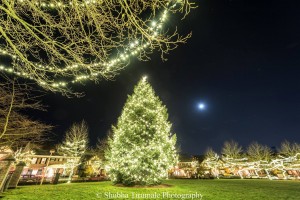 By Kathryn Dean, Vista Park
By Kathryn Dean, Vista Park
There’s nothing I love more than returning from Thanksgiving holiday, driving up Park Drive and seeing the trees all lit up for Christmas. I don’t know what’s so magical about strings of tiny lights, but when the streets and houses are illuminated the spirit in the air changes.
As a child I would beg to sleep under the Christmas tree to enjoy the twinkling “nightlights”. I didn’t care to stay up to see Santa; it was all about the campout under the Christmas lights – the one, peaceful, illuminated spot while the rest of the house was dark.
What is it about the lights that makes us feel festive and nostalgic? Perhaps it has to do with the brilliant light that ushered in the first Christmas.
I grew up in church where my dad was the pastor and hearing about that first Christmas years ago in Bethlehem. At some point I was forced to dress up as an angel with an itchy gold garland around my head, and march on stage with the other children to sing Hark the Herald Angels Sing. I had no idea what a Herald was, but I loved everything about the story of the baby Jesus born in a manger.
My favorite Christmas in the Highlands was the year Village Green became Bethlehem.* A wooden structure decorated with hay sat beneath the lighted tree with live animals from a nearby farm, including a camel, added to the scene. A star on top the tree served as the star of Bethlehem. A glowing angel floated atop the Starpoint condominiums. Hundreds of people visited the Nativity outside while Santa and Mrs. Claus read stories to children in Blakely Hall.
My parents never made much of Santa, choosing instead to focus on Christ, but I teach my kids about the original St. Nicholas as well. He was a rich, kind, bishop from the 4th century known for giving gifts to others. The story of Santa Claus coming at night bringing gifts began with his generous spirit.
Another memorable Highlands’ Christmas was marked by the absence of lights. During the storm of 2006 (our very first winter in the Highlands) we were without power for four days. Our whole family slept in the living room with the dark Christmas tree. We read books wearing headlamps while snuggled under blankets around scented candles.
But even darkness couldn’t dampen our Christmas spirit. Neighbors rallied together, checking on each other and organizing makeshift potlucks made from ingredients we could warm up on our gas cooktops. Many fled to relatives or hotels, but those of us who stayed took care of one another in the generous spirit of St. Nick.
With Park Drive full of lights once again ushering in another Holiday season, I hope that whatever our traditions, we won’t let the busy-ness of the season crowd out the love, joy, and peace represented by the Christ child, or the spirit of generosity demonstrated by St Nicholas.
But if it all becomes too stressful, you’ll find me napping under the lights of my Christmas tree.
No-Bake Chocolate Oatmeal Cookies
The Dean FAmily Favorite, Especially handing in winter when the power goes out.
YIELD – 24 cookies
1⁄2 cup butter or 1⁄2 cup margarine
2 cups sugar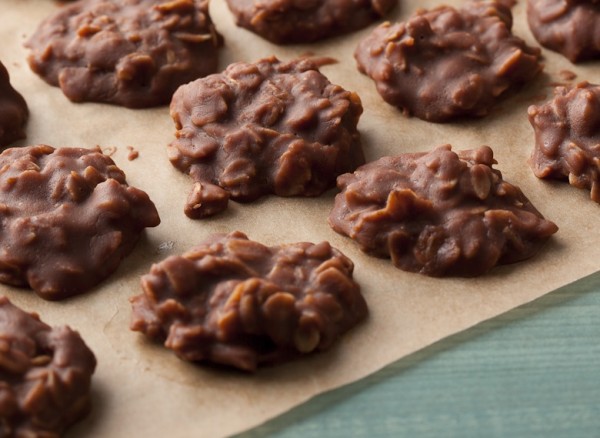
1⁄2 cup milk
4 tablespoons cocoa
1⁄2 cup creamy peanut butter (or chunky but is seems to make a more crumbly dry cookie)
2 teaspoons vanilla
3 -3 1⁄2 cups dry Old Fashioned oats (Or quick-cooking)
Directions:
- Add the first four ingredients into a 4-quart sauce pan.
- Bring to a rolling boil and hold for 1 minute.
- Remove from heat.
- Add peanut butter into the hot mixture and stir until melted.
- Add in vanilla. (almond extract is good also, but I only use 1/2 teaspoon almond and 1 1/2 teaspoon vanilla).
- Mix in the oats and drop by tablespoons onto wax paper.
- Let cool until set.
- *Please remember that even if you do follow the recipe exactly, it doesn’t always turn out just right. I have had these not set up for me AND be hard and dry. But most of the time, the recipe is just right. I have also found that it makes a difference if you use quick cooking oats or old fashioned. In my experience it takes more old fashioned oats than quick cooking and I like the texture of the quick cooking better. When you make it a few hundred times like I have you learn a couple of things:) Also, Chunky peanut butter tends to make them more dry and crumbly.

